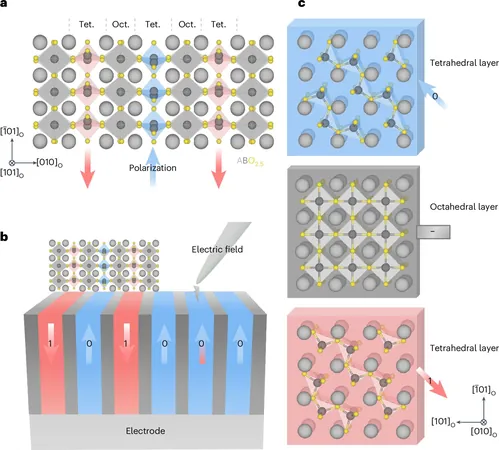
Unlocking Subatomic Memory: Nature’s Secret in Brownmillerite Could Revolutionize Tech
2025-05-27
Author: Benjamin
Groundbreaking Discovery in a Natural Mineral
A remarkable new discovery is set to change the landscape of electronic memory technology! A research team led by Prof. Si-Young Choi at POSTECH, in collaboration with prestigious colleagues from Pusan National University and Sungkyunkwan University, has unveiled ferroelectric phenomena occurring at a subatomic level in the natural mineral brownmillerite, featured in the esteemed journal Nature Materials.
The Challenge of Memory Density in Electronics
Traditionally, electronic devices rely on memory units called domains, which have size limitations that restrict the amount of data they can store. While ferroelectric-based memory offers promise due to its inherent properties, the challenge lies in minimizing these domain sizes, hampered by the collective behavior of atomic vibrations.
Nature's Ingenious Design as a Solution
The research team found their inspiration in the enchanting structure of brownmillerite, a mineral with alternating layers of tetrahedral and octahedral iron-oxygen arrangements, akin to a layered sandwich. This stunning configuration comes with an extraordinary feature: phonon decoupling.
Phonon Decoupling: A Game-Changer for Memory Storage
Phonons, the energy quanta of atomic vibrations, usually cause neighboring atoms to vibrate collectively. However, in brownmillerite, the vibrations of the tetrahedral layers remain largely independent of the octahedral layers. This groundbreaking property allows for the selective creation of domains within the tetrahedral layers when exposed to an electric field.
Experimental Validation and Practical Applications
The researchers confirmed this astonishing phenomenon across various brownmillerite specimens, including thin films and single crystals. Their experiments revealed that the electric field impacts only the tetrahedral layers, effectively altering atomic positions without affecting the nearby octahedral layers. This exciting finding has practical implications, leading to the successful development of ferroelectric capacitors and thin-film transistor devices.
A Leap Towards the Future of Memory Devices
If brought to market, this innovative technology could pave the way for memory devices that are not just smaller, but dramatically faster than anything currently available. Imagine smartphones and computers with storage capacities and processing speeds significantly enhanced, facilitating major breakthroughs in high-speed data processing fields such as artificial intelligence and autonomous vehicles.
Nature’s Wisdom: A Lesson for Technological Innovation
Prof. Si-Young Choi passionately stated, "This study illustrates how nature's design can inspire solutions to our technological hurdles. By unraveling the mysteries of unexplained natural phenomena, we could unlock an even broader spectrum of advanced technological applications."









 Brasil (PT)
Brasil (PT)
 Canada (EN)
Canada (EN)
 Chile (ES)
Chile (ES)
 Česko (CS)
Česko (CS)
 대한민국 (KO)
대한민국 (KO)
 España (ES)
España (ES)
 France (FR)
France (FR)
 Hong Kong (EN)
Hong Kong (EN)
 Italia (IT)
Italia (IT)
 日本 (JA)
日本 (JA)
 Magyarország (HU)
Magyarország (HU)
 Norge (NO)
Norge (NO)
 Polska (PL)
Polska (PL)
 Schweiz (DE)
Schweiz (DE)
 Singapore (EN)
Singapore (EN)
 Sverige (SV)
Sverige (SV)
 Suomi (FI)
Suomi (FI)
 Türkiye (TR)
Türkiye (TR)
 الإمارات العربية المتحدة (AR)
الإمارات العربية المتحدة (AR)